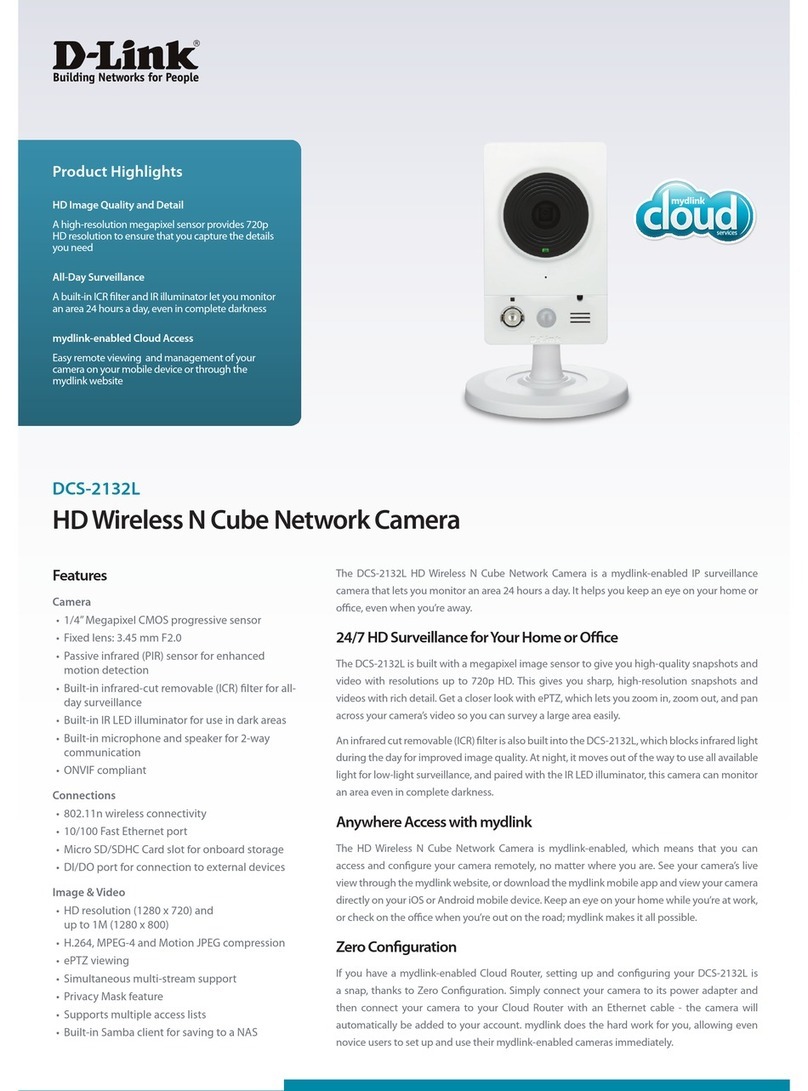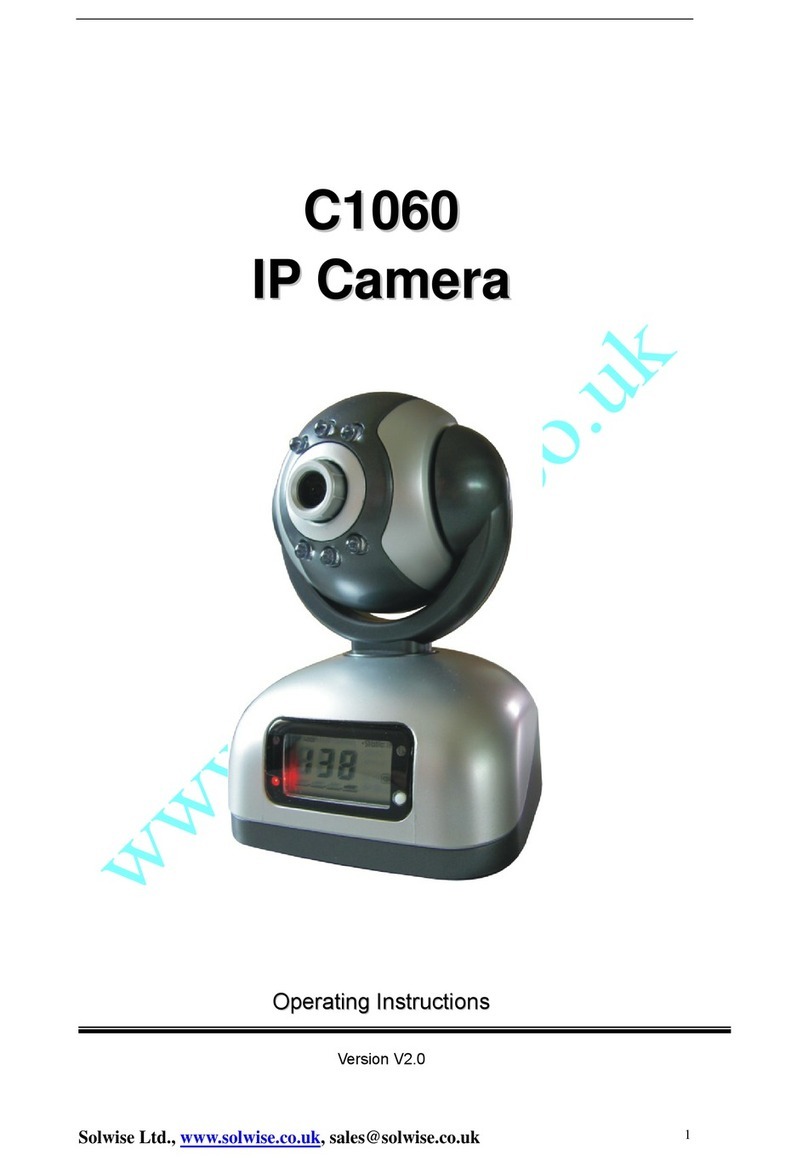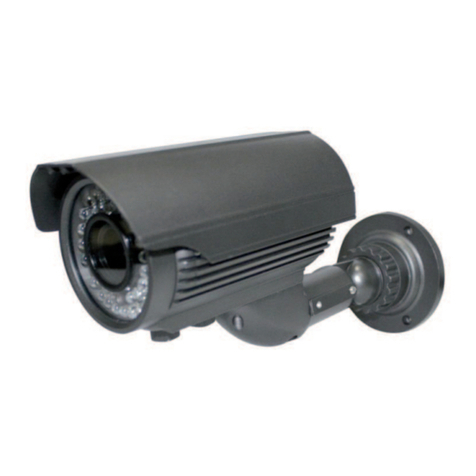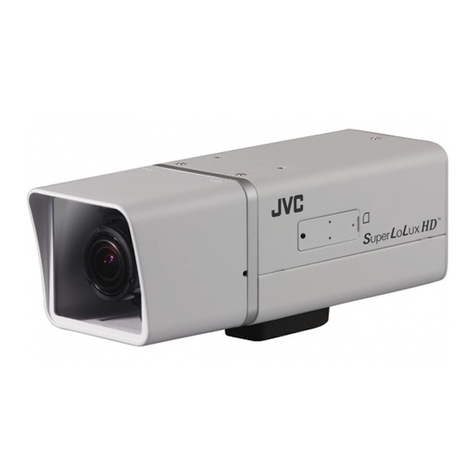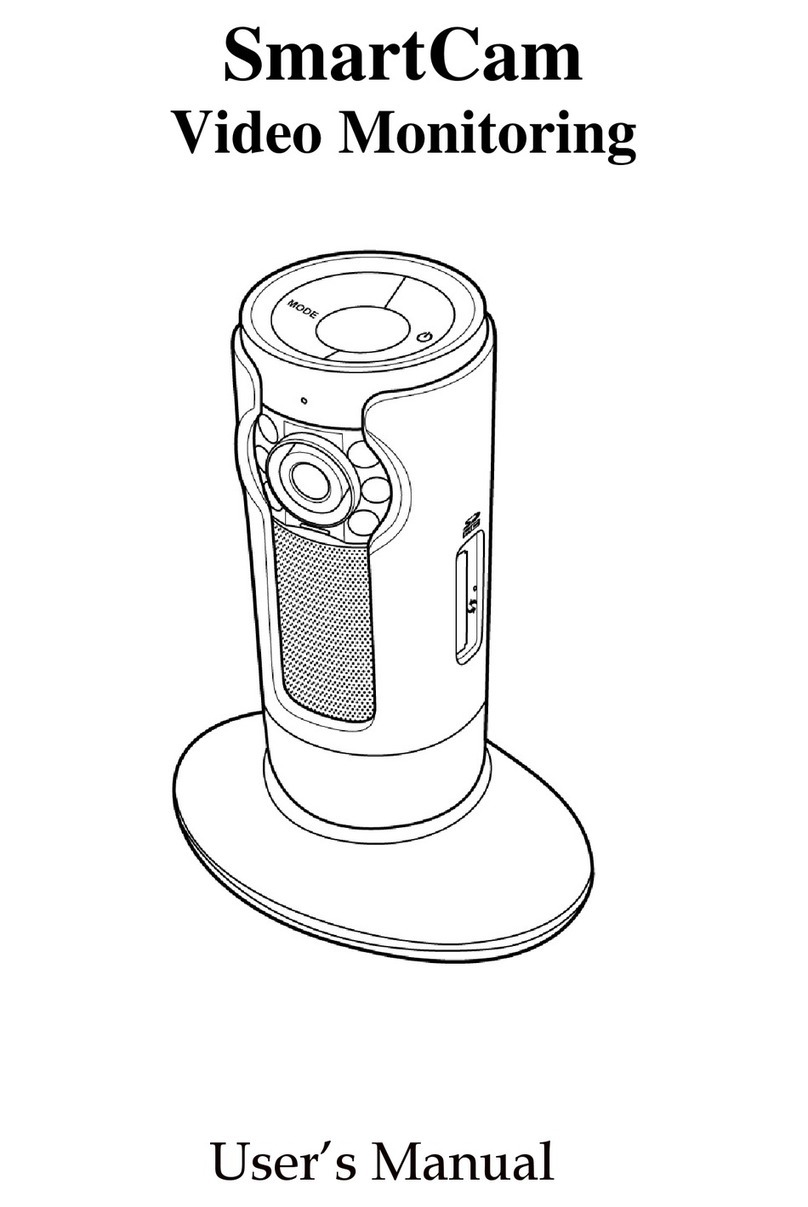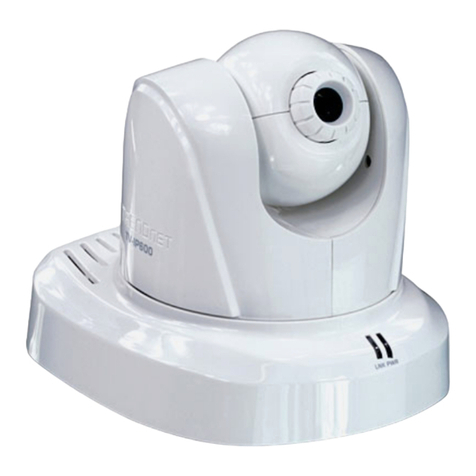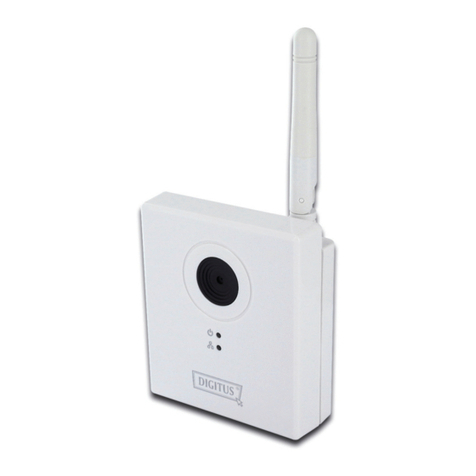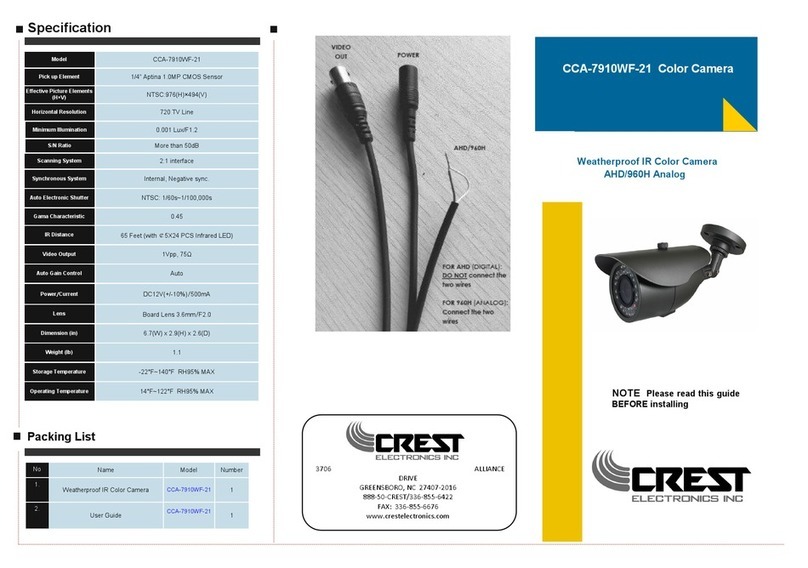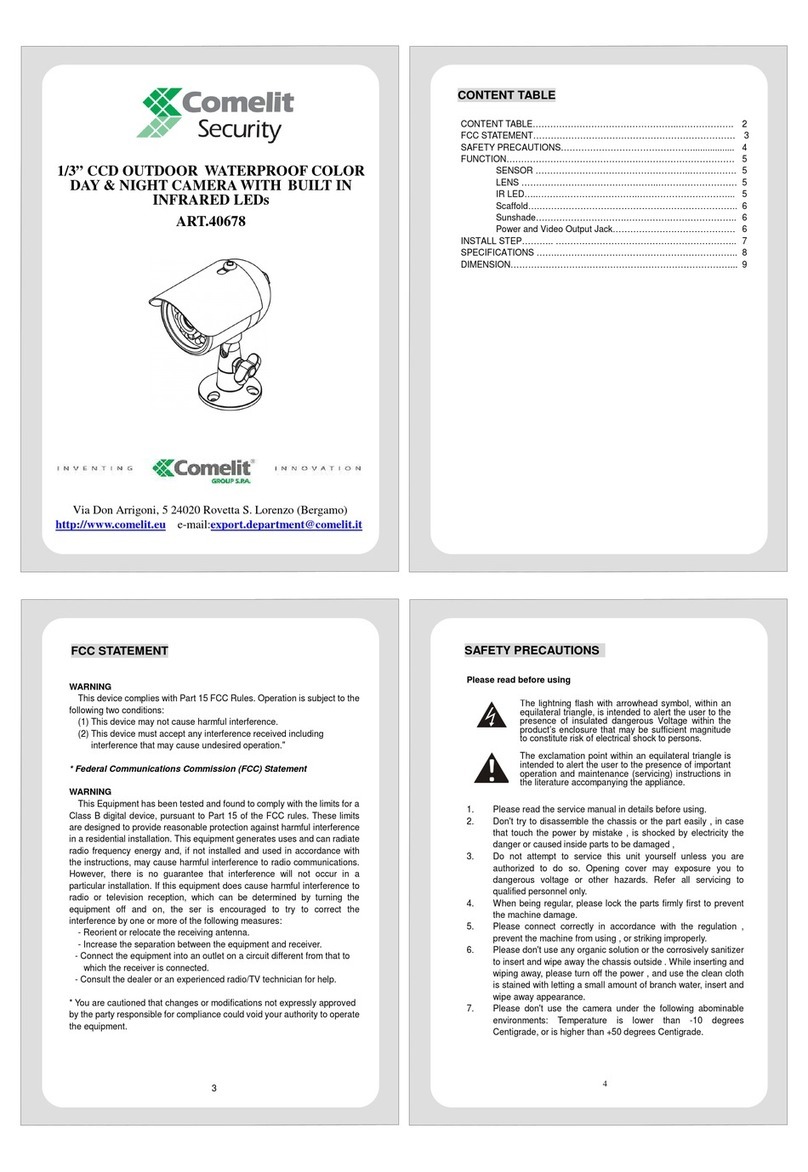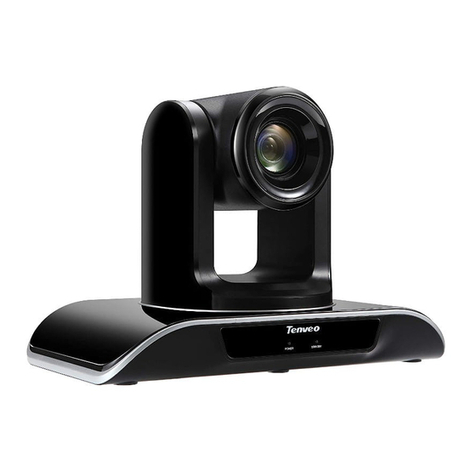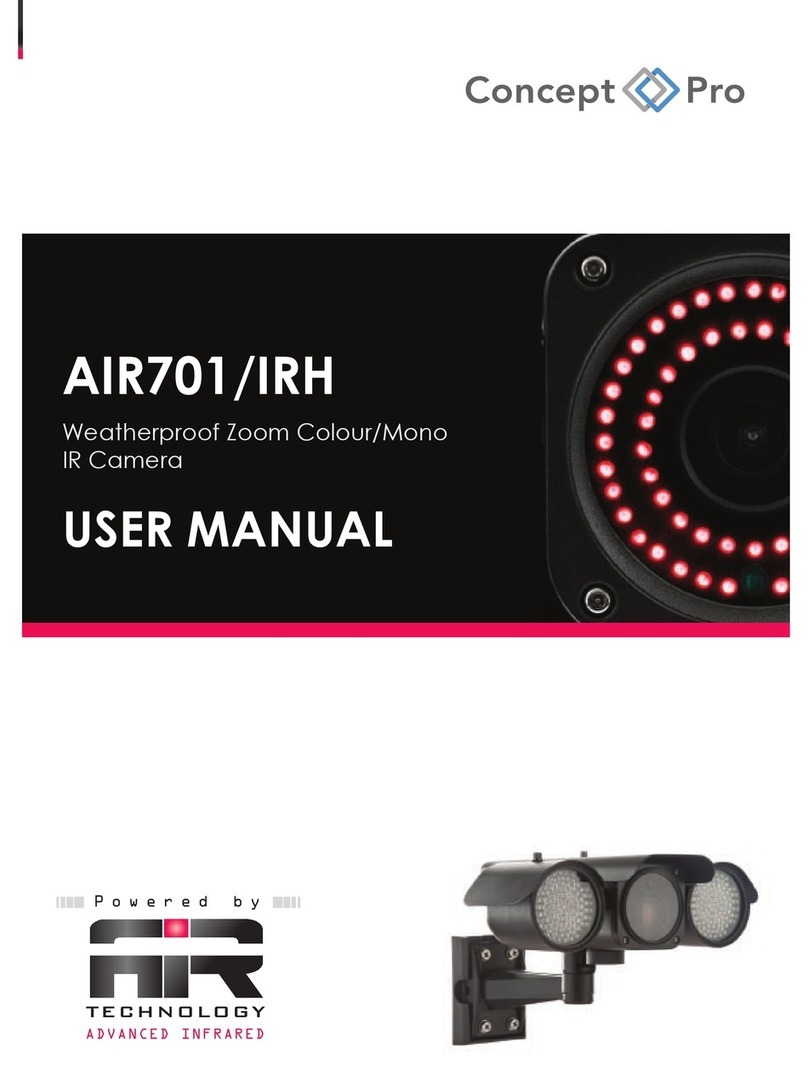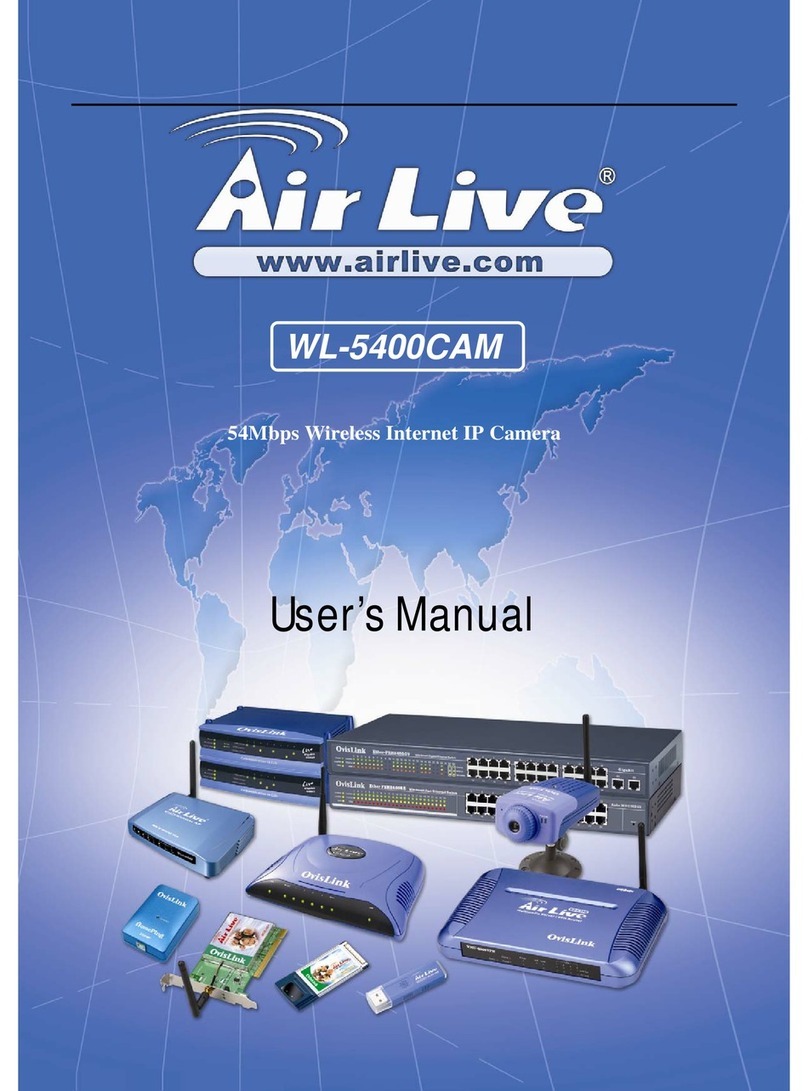Fike FVA-IP User manual

FIKE VIDEO ANALYTICS CORPORATION
Video Analytics Corporation
FikeVideoAnalytics®
FVA‐IPCamera
InstallationandOperationManual
P/N: 06-523
Rev:
6
,
06
/1
9

DEVELOPEDBY FikeVideoAnalyticsCorporation
704SW10thStreet
BlueSprings,Missouri64013‐0610U.S.A.
Phone:844‐345‐3843
COPYRIGHTNOTICE Copyright2014.Allrightsreserved.
FikeVideoAnalyticsCorporationcopyrightsthismanualandproductsitdescribes.
Youmaynotreproduce,transmit,transcribe,oranypartofthismanualwithout
express,writtenpermissionfromFikeVideoAnalyticsCorporation.
Thismanualcontainsproprietaryinformationintendedfordistributionto
authorizedpersonsorcompaniesforthesolepurposeofconductingbusinesswith
FikeVideoAnalyticsCorporation.Ifyoudistributeanyinformationcontainedin
thismanualtounauthorizedpersons,youhaveviolatedalldistributoragreements
andwemaytakelegalaction.
TRADEMARKSFikeVideoAnalyticsCorporationisaregisteredtrademarkofFikeCorporation.

FVA-IP Camera Installation and Operation Manual
Revision Date: June, 201 P/N 06-523 (Rev. 6) i
TableofContents
1.0 Introduction to Fike Video Analytics ................................................................................................................ 2
1.1FVA-IP Camera ................................................................................................................................................ 2
1.2Video Management Software User Interface .................................................................................................... 3
1.3Scalable System Architecture ........................................................................................................................... 4
2.0Fike Video Analytics System Design ................................................................................................................ 5
2.1System Design .................................................................................................................................................. 5
2.2Field of View (FOV) .......................................................................................................................................... 6
2.3Detection Range ............................................................................................................................................... 7
2.4Environmental Considerations .......................................................................................................................... 8
2.5Selecting Cable ................................................................................................................................................. 8
2.6Powering Up the System .................................................................................................................................. 9
2.7Network Configuration ...................................................................................................................................... 9
2.7.1Network Requirements ................................................................................................................................. 9
2.7.2Typical Configurations ................................................................................................................................ 10
3.0Installation ......................................................................................................................................................... 11
3.1IP Camera Setup ............................................................................................................................................ 11
3.2Power & Computer connections ..................................................................................................................... 13
3.3IP Camera Communications ........................................................................................................................... 15
3.4Operator Features .......................................................................................................................................... 17
3.5Administration Features .................................................................................................................................. 19
4.0Video Management System ............................................................................................................................. 30
5.0Fike Video Analytics Video Management Software ...................................................................................... 30
6.0Commissioning ................................................................................................................................................. 30
6.1Inspection, Testing, and Maintenance Recommendations ............................................................................. 31
6.1.1NFPA 72, Chapter 14 recommendations ........................................................................................................ 31
6.1.2Inspections ...................................................................................................................................................... 31
6.1.3Testing ............................................................................................................................................................ 31
6.1.3.1Difference in Functional and Operational conformance ............................................................................. 32
6.1.3.2Factors affecting Functional Conformance ................................................................................................. 32
6.1.3.3 Factors affecting Operational Conformance ............................................................................................... 32
6.1.4Testing for Operational Conformance ............................................................................................................ 33
6.1.4.1Fault Condition ............................................................................................................................................ 33
6.1.4.2Communication failure / Analytics failure .................................................................................................... 33
6.1.4.3Simulated response .................................................................................................................................... 33
6.1.5Maintenance ..................................................................................................................................................... 33
Appendix A – FVA-IP Camera Specifications ............................................................................................................. 35
Appendix B - Dry Contact Diagram ............................................................................................................................. 39
Appendix C – Fike Video Analytics System FM approved Computer Requirements ................................................. 41
Appendix D - Commissioning Paper Work ................................................................................................................. 43
Appendix E - Approved Fire Test Results ................................................................................................................... 49

Installation and Operation Manual FVA-IP Camera
ii P/N 06-523 (Rev. 6) Revision Date: June, 2019
Thispageintentionallyleftblank.

FVA-IP Camera Installation and Operation Manual
Revision Date: June, 2019 P/N 06-523 (Rev. 5) 1
IMPORTANTSAFETYINSTRUCTIONS
1. Readtheseinstructions.Keeptheseinstructions
2. Headallwarnings.Followallinstructions
3. Donotusethiscameranearwater.Cleanonlywithdrycloth.
4. Installinaccordancetothemanufacturer’sinstructions
5. Donotinstallnearheatsourcessuchasradiators,heatregisters,stoves,orotherapparatus(including
amplifiers)thatproduceheat.
6. Onlyuseattachments/accessoriesspecifiedbythemanufacturer.
7. Referallservicingtoqualifiedservicepersonnel.Servicingisrequiredwhenthecamerahasbeendamagedin
anyway.
8. WARNING:Toreducetheriskoffireorelectricshock,donotexposethiscameratorainormoisture.
9. Installationshouldbedoneonlybyqualifiedservicepersonnelandconformtolocalcodes.
10. Ensurethatthecameraissecurelymounted.Useinstallationmethodsandmaterialscapableofsupporting
fourtimesthemaximumspecifiedload.
11. Onlypowerwith12‐24VDC(UL),12VDC(FM)fromULlistedClass2powersupplyforsecurityorfireshould
beused.POEmaybeusedassupplementaltothelisted12or24voltpowersupply.
12. Pleasethoroughlyfamiliarizeyourselfwiththeinformationinthismanualpriortoinstallationandoperation.
13. Thisdevicecomplieswithpart15oftheFCCRules.Operationissubjecttothefollowingtwoconditions:(1)
Thisdevicemaynotcauseharmfulinterference,and(2)thisdevicemustacceptanyinterferencereceived,
includinginterferencethatmaycauseundesiredoperations.
14. ThisClassAdigitalapparatuscomplieswithCanadianICES‐003.CetappareilnumériquedelaclasseAest
conformeàlanormeNMB‐003duCanada.
Approvals:

Installation and Operation Manual FVA-IP Camera
2 P/N 06-523 (Rev. 6) Revision Date: June, 2019
1.0 IntroductiontoFikeVideoAnalytics
FikeVideoAnalyticsissoftwarebasedtechnologythatusesanalyticstocontinuouslymonitorvideo—frame‐by‐frame,
pixel‐by‐pixel ‐‐ to detect anomalies characteristic of smoke, fireandmotion.WiththeFikeVideoAnalyticsvideo
managementsoftwareuserinterface,FikeVideoAnalyticsearlyfireandsmokedetectioncapabilityisunmatchedby
anytraditionalsmokedetectiontechnology.
FikeVideoAnalytics,locatedwithinaTexasInstrumentschiponboardtheFVA‐IPcamera,candetectaflamingfireina
7 by 7 pixel area, as well as both ambient and plume like smoke patterns. The Fike Video Analytics system is also
capableofdetectingreflectedfirelightoffwallsorobjectssothatafirecanbedetectedeveniftheflamesarenotin
thecamera’slineofsight.
NOTE:ThereflectedfirelightalgorithmisnotanFMapproveddetectionmethod.
Unlikespot‐typesmokedetectorsortemperaturesensors,TheFVA‐IPcameraisavolumesensor,whichobservesand
identifiesthefireconditionwithintheentireobservedspaceoftheCCTVcamera.Thisfundamentaldifferenceresults
infasterfireandsmokedetectionand,mostimportantly,provides a visual picture of the situation to responding
personnel.Intheeventofafireortheproductionofsmoke,theFVA‐IPcamera“sees”theeventandissuesawarning
signal.
EachFikeVideoAnalyticssystemincludes:
AtleastoneFVA‐IPCamera.
Thevideomanagementsoftwareuserinterface.
AVideoManagementSystem.
1.1 FVA‐IPCamera
TheFVA‐IPcameraisacolorcamerawithamicron1/3‐inchCMOSMT9M11Imager,TexasInstrumentsTMS320DM642
chip,DigitalMediaProcessor,128MBRAM,andbatterybackeduprealtimeclock.AllcamerasacceptafixedIrisand
fixedFieldOfView(FOV)CSmountlenssuppliedbythemanufacturerfor2.8mmand8mmFOV.Eachlensallowsfor
focusadjustments.TheFVA‐IPCameraprocessesvideoinreal‐timetransmittingthevideothroughcoaxoranetwork
tothemanagementsystemandtheFikeVideoAnalyticsvideomanagement software. When an early warning
conditiondoesoccur, theFikeVideoAnalytics createsaneventfileandsendsittothevideomanagementsoftware
operatingonaremotePCworkstationinthesystem.Theon‐dutyoperatororremotemonitoringcenterreceivesan
earlywarningnotificationalongwithlivevideofromthelocation.

FVA-IP Camera Installation and Operation Manual
Revision Date: June, 2019 P/N 06-523 (Rev. 5) 3
1.2 VideoManagementSoftwareUserInterface
WithFikeVideoAnalyticsvideomanagementsoftwareuserinterface,youcanuseanapprovedworkstationforvideo
surveillance, fire safety monitoring, and to configure any numberofcameras.Thesoftwareprovidesthetoolsto
monitor your facilities, build an organization tree and import plant site drawings, building schematics, and photos.
Figure1isanimageofthevideomanagementsoftwareuserinterface.
Fig1–SnapshotoftheVideoManagementSoftwareUserInterface.

Installation and Operation Manual FVA-IP Camera
4 P/N 06-523 (Rev. 6) Revision Date: June, 2019
1.3 ScalableSystemArchitecture
A Fike Video Analytics system is comprised of at least one FVA‐IP camera, a video management system, and the
monitoring solution. You can connect any number of FVA‐IP cameras and network recorders via standard LAN /
Ethernetnetworktoexpandthesystemtomeetenduserneeds(limitof32cameraspernetworkrecorder).FVA‐IP
cameras can be powered by a FM approved fire alarm control panel(FACP),anapprovedsecurityandfirecamera
power supply with battery backup, or as a supplemental means a Power‐Over‐Ethernet (POE) switch with battery
backup.WiththeFikeVideoAnalyticsvideomanagementsoftware,anyapprovedPCworkstationcanbeusedasa
monitoringsystemsolongasitisconnectedthroughastandardIPnetworkconnection.Figure2isanexampleofthe
scalableenterprisearchitecture.
Fig2–TypicalinstallationofaFikeVideoAnalyticssystemwith8FVA‐IPcameras,aFSM‐IPvideomanagementsystem,
andaLANnetworkconnectedtosecurityworkstationandremotemonitoringofthesite.
FikeVideoAnalyticscomeswithavideomanagementsystemcalledFSM‐IPNetworkVideoRecorder(NVR).TheNVR
providesastoragepointforvideoalarmsfromtheFVA‐IPCamerasandacts asaninformationconduitbetweenthe
videomanagementsoftwaremonitoringstationandthecamerasthemselves.ThenumberofFVA‐IPcamerasthatcan
be supported in any Fike Video Analytics installation is dependentonthespeedandrobustnessofthenetworkto
which the cameras are attached. It is this flexibility of number of cameras, NVR platforms, and video management
softwaremonitoringstationsthatmakesFikeVideoAnalyticssystemsscalabletoanysizeapplication.

FVA-IP Camera Installation and Operation Manual
Revision Date: June, 2019 P/N 06-523 (Rev. 5) 5
2.0 FikeVideoAnalyticsSystemDesign
Thesystemdesignshouldincludethepropercoverageofthehazardareaaswellasmonitoringoftheeventsrecorded
bytheFVA‐IPcameras.Themonitoringcanbedonebyon‐sitesecurityoraremotemonitoringfacility.Thesystem
architectureisveryflexibletosuittheendusersneedsandcareshouldbetakenwhendesigningthesystemlayoutto
meettheneedsoftheenduser.Someexamplesofthevaryingarchitecturesinclude:
WiringthecamerasdirectlytothedrycontactsofaFMapprovedFACP
Connectingthecamerastoon‐sitemonitoringusingthecoaxortheLANconnection
Configuringthecamerastoberemotelymonitoredbyathirdpartyorcorporatesite
Usingavideomanagementsystemtorecordeventsforposteventanalysis
Anycombinationofarchitecturecanbecombinedtoproducethedesiredresults.
2.1 SystemDesign
NOTE:AlltherequirementsofNFPA72,includingbutnotlimitedto,back‐uppowerrequirements,maintenance
requirements,andperformance‐basedinstallationcriteriashouldbefollowed.
NOTE:Powerwith12‐24VDC(UL),12VDC(FM)fromULlistedClass2powersupplyforsecurityorfireshouldbeused.
POEmaybeusedassupplementaltothelisted12or24voltpowersupply.
TheFVA‐IPcamerashouldbeconnectedtoeitherPower‐Over‐Ethernet(POE)ora12/24VDC1A,Class2powersupply
certifiedforusewithsecurityandorfireapplicationsonly.Bothcanbeusedtogetherforredundancy.Electricalratings
canbefoundontheFVA‐IPcameras.Ifyouareunsureofcameraplacement,youmaywanttoperformaFireHazard
Analysis(FHA)andoraperformance‐baseddesignanalysistodeterminetheproperplacementandnumberofcameras
toadequatelyprotectthearea.Itisimportanttoconsiderthedesiredperformanceandpreventionofnuisancealarms.
Takeintoaccountpredictedsmokeflow,ceilingobstructions,configurationofcontents,lighting,anddesiredfiresizeat
detection.
Thelocationandspacingofcamerasshouldbetheresultofanengineeringevaluationthatincludes:
Sizeandtypeoffiretobedetected
Fuelinvolved
Detectorsensitivity
CameraFieldofView(FOV)
Distancebetweenfireandcamera
Purposeofthedetectionsystem
Responsetimerequired
Sourcesoflight
Obstructions
The FVA‐IP camera relies on “seeing” smoke and flames. The presence of intervening structural members and/or
intermittent opaque objects or materials in front of the cameras can compromise its ability to respond to the fire.
Obstructions in the cameras FOV are acceptable, as long as the obstructions do not compromise the ability of the
systemtodetectthedesiredfiresizeandtypeintheallottedresponsetime.Mountcamerastoensureobjectsthat
willappearlargetoitwillnotpassinfrontoforthroughitsFOV;forexample,apersonstandingcloserthan5ft.(1.5
m)pastthecameraoravehicleparkinginfrontofthecamera.

Installation and Operation Manual FVA-IP Camera
6 P/N 06-523 (Rev. 6) Revision Date: June, 2019
Cameras should be mounted high and away from interferences so they can overlook the area of protection. The
camerashouldbemountedsothatlargesourcesoflight(glasswalls,largebaydoors,ordirectionalspotlights)willnot
compromisetheimagequalitybysaturatingtheimagesensorwithlight.Ideally,theFOVwillincludeboththeceiling
andfloorofthefacility,asshownintheFigure3below.
Fig3‐ThecameraispositionedhighinthespaceandtheFOVcoversboththefloorandceiling,maximizingthearea
covered.Thecamerawasmounted15ft.(4.6m)highwitha70ft.(21m)unobstructedviewdownthelengthofthe
warehouse.
2.2 FieldofView(FOV)
The most significant factor affecting system performance is the camera positioning and the resulting FOV. It is
importanttopositioncamerastomaximizetheFOVaswellastheareacoveredbythecameras.Aperformancebased
designshouldbeusedtodeterminethenumberofcamerasneededtoproperlycoverthespacefromthedetermined
firethreat.Table1showstheresponsetimestovariousfiresources.Camerasshouldbeplacedhighinthespacesoas
tooverlookthehazardareaandavoidobjectswithin7ft.(2m)ofthecamera.

FVA-IP Camera Installation and Operation Manual
Revision Date: June, 2019 P/N 06-523 (Rev. 5) 7
Table1–DetectiontimesinsecondsofIPcameramodelstovarioussources.
FuelSource Distanceto
detector 2.8mmFOV 6mmFOV 8mmFOV EX8mm
FOV
1ftpanofHeptane 100ft 18 9 9 9
1ftpanofJP‐8 100ft 18 10 10 10
1ftpanofEthylAlcohol 100ft 21 10 11 11
1ftpanofIsopropylAlcohol 100ft 16 9 9 10
1ftpanofUnleadedGasoline 100ft 8 8 8 9
4minSmokeEmitter 100ft 301 94 52 63
4minSmokeemitter 75ft 43 24 22 48
6inpanofHeptane 100ft 100 10 9 10
Cardboardboxesandpaper
4ea.10x10x4‐in.boxes 100ft 278 83 101 97
6indiameterpanof
Heptane/toluene75/25 28ft 19 19 20 18
Shreddednewspaper 28ft 127 150 102 151
Smolderingwood 28ft 3062 3279 3027 2927
WoodCrib6x6x2.5‐in. 28ft 142 192 145 194
NOTE:Knownnuisancesourcesinclude:Welding,grinding,modulatedlightsources,anddirectionallightsources.
2.3 DetectionRange
After proper camera positioning, detection range is the second most important consideration. The most sensitive
detectionalgorithmtodistanceisflamedetection,becauseitreliesondirectflameimagepatternanalysis.Todetecta
flame, the pattern must be at least 7 by 7 pixels in size. Youcanperformcalculationstodeterminearelationship
between the distance and lens angle to the fire size at detection. The range of potential smoke sources and their
correspondingopticaldensitiesmakesitdifficultto theoretically estimate theexactdistanceat whichathresholdof
smokedetectionwillbereached.TheOffsitedetectionmethoddependsonavarietyoffactorssuchasthepresence
andpropertiesofreflectingsurfaces,thetypeofcombustible,andthelightingconditions.Theoffsitealgorithmisnot
FMapprovedbecauseofthesemanyvariables.
Camerasshouldbeplacedsothatcoveragewilldetectthedesiredfiresizeandtypeconsistentwiththehazardarea.
Thenumberofcamerasneededshouldbedeterminedonthebasis ofcameraposition.Unlikemanyradiantenergy
sensingfiredetectors,flamesthatareobstructedoroutsidetheFOVmaybedetected,dependingonthenumberof
obstructionsandthereflectivepropertiesofthesurroundingsurfaces.Videoflameandsmokedetectorperformance
is relatively uniform across the plane intersecting a source’s optical axis. Unlike fire detectors that sense radiant
energy,correctionsforfiresizevs.distanceneednotbegivenforfiresthatmayoccurawayfromtheopticalaxisofthe
detector.YoucanalsoassumethatsmokestartingoutsidetheFOVofacameramaydriftintotheFOV.Whilethese
featuresprovideextradetection,the primaryobjectiveistoensurethatallregionsrequiringdetectioncoverageare
withintheFOVofatleastonecamera.Crosszoningcamerasalsoprovidesanopportunitytoreducenuisancealarms
causedbydirectionallightsources.

Installation and Operation Manual FVA-IP Camera
8 P/N 06-523 (Rev. 6) Revision Date: June, 2019
2.4 EnvironmentalConsiderations
TomaximizethefiredetectionpotentialoftheFikeVideoAnalyticssystem,thecameralensesshouldbeproperlyset
upto ensuresharpimages.UsingaportableTVwiththeBNCconnectionattachedtothebackoftheIPcamerawill
allow localized adjustment to optimize the image focus. Lenses should be clean and free of scratches. Camera
positioningshouldconsiderlight saturationandconsistency,mountingintegrity,humidity, airborneparticulates,and
otherpotentiallydamagingambientconditions.Brightlightsourcesshouldbelocatedbehindthecameras.
The area to be protected should be uniformly illuminated; fluctuations caused by natural light should be limited.
Camerasshouldbesecurelymountedtopreventvibration,swinging,andothercameramotion.Excesshumiditymay
causefoggingofthelensesthatmaytriggerthesystem.
Makeprovisionto sustain camera lens clarity in applications whereairborneparticulates and aerosols may coat the
cameralens betweenmaintenanceintervalsandaffectsensitivity.Camerasshouldbeprotectedeitherbydesignor
installationtoensurethatperformanceisnotcompromised.Whenusedinconditionsthatwillexposethecamerato
extremeconditions,thecamerasshouldbeshieldedorotherwisearrangedtomaintainperformancewhenexposedto
thoseextremeconditions.Thecamerasshouldnotbeinstalledinalocationwhereambientconditionsareknownto
exceedtheextremesfor which they have been listed (see specificationsAppendixA). Nuisance sources includebut
maynotbelimitedtowelding,modulatedlightsources,andlocalizedfluctuationsinlighting.Theareatobeprotected
shouldbeuniformlylitattheULminimumof1foot‐candle(10lux)measuredatthefloorlevelforthehazardareaor
the FM approved 4.8 Fc (~48 lux) at 30 inches (76 cm) above thefloorsurface.Generallightingshallmeetthe
minimumemergencylightingrequirementsofNFPA101(1Fc(10Lux))andshallnotproducealowlightcamerafault.
2.5 SelectingCable
Thereareseveralclassificationsofcableusedfortwisted‐pairnetworks.WerecommendCategory5(orCAT5)cable
forallnewinstallations.ThereareseveralfirecodeclassificationsfortheouterinsulationofCAT5cable.CMRcable,
or"risercable,"isthemostcommon,however,CMPorplenumcableisalsoavailableandmayberequiredbylocal,
stateornationalcodesifitwillberunningthroughsuspendedceilings,ducts,orotherareas,thatareusedtocirculate
airoractasanairpassagefromoneroomtoanother.Stranded wire patch cables are often specified for cable
segmentsrunningfromawalljacktoaPCandforpatchpanels.Theyaremoreflexiblethansolidcorewire.
CAT5cablehasfourtwistedpairsofwireforatotalofeightindividuallyinsulatedwires.Eachpairiscolorcodedwith
onewirehavingasolidcolor(blue,orange,green,orbrown)twistedaroundasecondwirewithawhitebackground
andastripeofthesamecolor.Thesolidcolorsmayhaveawhitestripeinsomecables.Cablecolorsarecommonly
described using the background color followed by the color of thestripe;e.g.,white‐orangeisacablewithawhite
backgroundandanorangestripe.
The straight through and cross‐over patch cables are terminatedwithCAT5,RJ‐45modularplugs.RJ‐45plugsare
similartothoseyou'llseeontheendofyourtelephonecableexcepttheyhaveeightversusfourorsixcontactsonthe
endoftheplugandtheyareabouttwiceasbig.MakesuretheyareratedforCAT5wiring.(RJmeans"Registered
Jack").Also,thereareRJ‐45plugsdesignedforbothsolidcorewireandstrandedwire.Othersaredesignedspecifically
foronekindofwireortheother.Besureyoubuyplugsappropriateforthewireyouaregoingtouse.

FVA-IP Camera Installation and Operation Manual
Revision Date: June, 2019 P/N 06-523 (Rev. 5) 9
2.6 PoweringUptheSystem
Thesystemandallitselectricalcomponentsshouldbesuppliedwithpowerfromanuninterruptedpowersource.This
willensurethatthecameras,guardstation,andnetworkwillremainfunctioningoverthecourseofpowerloss.The
amphourforthesystemtomaintainpowerwillvarydependonthenumberofcamerasused.Calculationsshouldbe
conductedtoensureadequatebackuppowerisavailabletomaintainthesystemfor24hours.
NOTE:BackuppowersupplyforcamerasshouldadheretotherequirementsofNFPA72andbeNRTLcertifiedforfire.
NOTE:Powerwith12‐24VDC(UL),12VDC(FM)fromULlistedClass2powersupplyforsecurityorfireshouldbeused.
POEmaybeusedassupplementaltothelisted12or24voltpowersupply.
Thevoltagerequiredtooperatethecameraisclearlymarkedontherearpanelofthecamera.ThegreenpowerLED
ontherearandfrontoftheIPcameraindicatesthatpowerisconnected. Powerconsumptionisapproximately 5.0
Watts.TheIPCameraisfittedtoautomaticallyswitchbetweenlowvoltagepowersupplyandPOEifoneistofail.
NOTE:AllwiringshouldbedoneaccordingtoNEC70practices.
2.7 NetworkConfiguration
NOTE: If your organization uses static IP addresses (i.e. does not use DHCP services) you must provide specific IP
addressestocompletethefollowingsteps.ContactyourITrepresentativeorsystemadministrator.
ConsiderthefollowingwhenconfiguringtheNetworkconnections:
Typeofnetworkcurrentlyin‐placewithintheorganization
IPandDNSconfigurationoptions(automaticormanual)
Numberofcamerasresidingonthesamenetwork
Futureexpansionplans(howmanycamerasmaybeadded)
Whowillaccessthesystemandfromwhere(localnetworks,Internet).
2.7.1 NetworkRequirements
TypicalbandwidthtotransfervideofromtheIPcameratotheVideoManagementSystemisminimal.Eachframeis
approximately40to60kbinsize.Therefore,onecameraat2framespersecond(fps)resultsin120kbps.Anoperator
displaying48camerasatonce,(48x120x8)resultsin46,080kbps(46.0Mbps),whichislessthan50%capacityof100
MBnetworkorlessthan5%capacityofa1GBnetwork.However,itishighlyunlikelythatanoperatorwouldview48
camerasatonceononeFikeVideoAnalyticsvideomanagementworkstation,norwouldtheyneedtodoso.

Installation and Operation Manual FVA-IP Camera
10 P/N 06-523 (Rev. 6) Revision Date: June, 2019
2.7.2 TypicalConfigurations
NOTE:Bydefault,theEthernetconnectionisfactory‐presetforafixedIPconfiguration.IfyourorganizationusesDHCP,
donotconnectthecameratothenetworkuntiltheNetworksetup has been completed. Refer to section 3.5 for
details.
The typical Fike Video Analytics setup will be similar to the one shown in Figure 4 and includes the following
components: FVA‐IP Camera(s) connected by CAT‐5 cable to a network hub or LAN, connecting the monitoring
workstation running the Fike Video Analytics video management software and the FSM‐IP NVR. In addition, dry
contactconnectionsareprovidedoneeachFVA‐IPcamerasothesystemcanbetiedintoaFMapprovedFACP.ABNC
connectionisprovidedso a coax connection canbeusedwithlegacysystems..AppendixBprovidesadiagramfor
identifyingandattachingthedrycontactoutputs.
Figure4‐TypicalFikeVideoAnalyticsNetworksetupforsmallinstallation:FVA‐IPCameras,VideoManagement
system;Networkhub/LAN;Guardstation;Internet.
NOTE:Thissectionprovidesinformationforconfiguringabasicsystem.Formoreinformation,contactyourIT
representativeorsystemadministrator.

FVA-IP Camera Installation and Operation Manual
Revision Date: June, 2019 P/N 06-523 (Rev. 5) 11
3.0 Installation
TypicalFikeVideoAnalyticsinstallationiscompletedinfourbasicsteps:
Configure,andinstallFVA‐IPCameras
Installthevideomanagementsystem
InstallandconfigureFikeVideoAnalyticsvideomanagementsoftwareonworkstation
ConfigureandcommissiontheFikeVideoAnalyticssystem.
Completeinstructionstoperformeachsteparepresentedinthefollowingsectionsandwithinthevideomanagement
softwareUsermanual.
NOTE:AllwiringshouldbedoneaccordingtoNEC70practices.Camerasshouldbeconnectedto24VDC,or12VDC
1AClass2NRTLcertifiedforsecurityandfirepowersupply.
NOTE:Powerwith12‐24VDC(UL),12VDC(FM)fromULlistedClass2powersupplyforsecurityorfireshouldbeused.
POEmaybeusedassupplementaltothelisted12or24voltpowersupply.
NOTE:Itisimportanttocreateapermanentrecordofallcamerasettingsuponinstallation(seesection3.5)andwhen
any changes are made. These records will be useful for regularsystemmaintenanceandanyfutureincident
investigation.
NOTE:TheFikeVideoAnalyticsdetectionsystemshallcomplywithallapplicablerequirementsofNFPA72,including
butnotlimitedto,back‐uppowerrequirements,maintenancerequirements, and performance‐based installation
criteria.
NOTE:Thesystemmaintainsasupplementalstatustoenhancefiredetectionandprotectionofassetsandproperty.
NOTE: Only personnel trained andcertified to install the FVA‐IP Camera should install and commission a Fike Video
Analyticssystem.InstallationshouldbeinaccordancetotheinstructionswithinthismanualandNFPAguidelines.
3.1 IPCameraSetup
Oncethecameralocationshavebeenselected,theentireprocedurewillconsistofthefollowingsteps:
UnpackandinspectIPCameras
PowerupandconnecttotheIPcamera
Configurecamera
Installcameraandsetfocus.
Commissioncameras
Unpack the camera. Inspect both cameras and attached lens for defects or damage. Familiarize yourself with the
camera layout and all of it connections, Figures 5 and 6. The FVA‐IPcameraoffersstandardpowerandcoaxvideo
connectorsaswellasanRJ45‐10connectorthatacceptsPOE,threeconfigurabledrycontactclosers,andapowerout
connectionforapprovedaccessories.

Installation and Operation Manual FVA-IP Camera
12 P/N 06-523 (Rev. 6) Revision Date: June, 2019
Fig5–BackplaneoftheFVA‐IPcamerashowingthelayoutoftheLED’s,anddrycontact,Ethernet,BNC,powerin,
powerout,andaudioconnections.Powerwith12‐24VDC(UL),12VDC(FM)fromULlistedClass2powersupplyfor
securityorfireshouldbeused.POEmaybeusedassupplementaltothelisted12or24voltpowersupply.
Fig6–FrontPlaneoftheFVA‐IPcamerashowinglocationoftheC/CSLensmountandFrontpanelLED.Alsothe
dimensionsofthelensareshown.
Pins 12-13 NOT used.

FVA-IP Camera Installation and Operation Manual
Revision Date: June, 2019 P/N 06-523 (Rev. 5) 13
There are three LED’s located on the FVA‐IP camera; front, rightrearandleftrear.Thecolorofthepulseandthe
resulting state are listed in Table 4. The Front LED provides the alarm condition of the camera. The left rear LED
indicates the condition of the network connection for trouble shooting purposes. The right rear LED indicates the
stateoftheimagecollectionandinternalprocessingoftheimagesbytheanalytics.
FrontLED
Color State
GreenPulse(1secinterval) Normal
GreenPulserapid Motion
YellowPulse Trouble
RedPulse Alarm
LeftRearLED(reffromrear)
GreenPulse Networknormal
RedPulse NetworkFailure
YellowPulse httpserverFailure
RightRearLED(reffromrear)
GreenPulse Every15thframe(Imagetask)
YellowPulse CameraControlTaskFailure
RedPulse ImageTaskFailure
Table4:ColorandStateofthethreeLED’slocatedontheIPcamera.
Torunthe FVA‐IPcamerainterfaceandconfigurethe cameraacomputer witheitherFireFoxor InternetExploreris
required.IfInternetExplorerisused,Javamustbeproperlyinstalledanduptodateinordertoseethevideofeed.
FireFoxcanbeeasilydownloadedandwillrunbothJavaandmultipartstreamvideofeedoptions.
InadditiontothewebbrowseranetworkconnectionwithafixedIPconfigurationmustbeestablished.TheFVA‐IP
cameracomespre‐configuredwithaFixedIPaddressof192.168.0.100.Thisrequiresthecomputerusedtoconfigure
thecamerabesettoa fixed IP to initially communicate withthecamera,forexample192.168.0.1.Oncetheinitial
communication is acquired, the camera can be configured to function on a DHCP or a Fixed IP Network and its IP
addresscanbechangedtospecificallyidentifythecamera.
3.2 Power&Computerconnections
TosetyourcomputertoafixedIP:
1. SelectStart>ControlPanel>NetworkandInternetConnections.
2. ClicktheNetworkConnectionsicon.
3. Right‐clicktheLocalAreaConnectioniconandselectProperties.TheLocalAreaConnectionPropertiesdialog
boxopens.

Installation and Operation Manual FVA-IP Camera
14 P/N 06-523 (Rev. 6) Revision Date: June, 2019
4. SelectInternetProtocol(TCP/IP)andclickthePropertiesbutton.TheInternetProtocol(TCP/IP)Properties
dialogboxopensattheGeneraltab.
5. SelectUsethefollowingIPAddressandentertheIPaddressinthecorrectrange(192.168.0.1to
192.168.0.256,subnetmask255.255.255.0.
6. ConnectthecomputertoaHUBandtheIPcameratothesameHUBusingCAT‐5cables.
YouarenowreadytopowerupandconnecttotheIPCamera.Notethecamerasbydefaultaresetto
192.168.0.100soyoucannotusethisaddressfortheNVRoryouwillcreateanIPaddressconflict.

FVA-IP Camera Installation and Operation Manual
Revision Date: June, 2019 P/N 06-523 (Rev. 5) 15
ConnecteitheranEthernetCAT‐5cablewithPOE,12or24VDCcamerapowersupplytotheappropriatepower
contactsontherearoftheFVA‐IPcamera.
NOTE:Powerwith12‐24VDC(UL),12VDC(FM)fromULlistedClass2powersupplyforsecurityorfireshouldbeused.
POEmaybeusedassupplementaltothelisted12or24voltpowersupply.
ConnecttheEthernetcabletoahubandattachthelaptoporworkstationusedtoconfigurethecameratothehub.
3.3 IPCameraCommunications
Openthepreferredinternetbrowser(FireFoxorInternetExplorer)andtypehttp://192.168.0.100/adminintheaddress
bar.Iftheconnectionissuccessfulyouwillbepromptedforausernameandpassword,Figure7.Thefactorydefault
usernameandpasswordareadminandaxonx,respectively.
Fig7–Requiredusername(admin)andpassword(axonx)toestablishconnectiontotheFVA‐IPcamera.
FV
A
-IP Camera to
be configured
(192.168.0.100)

Installation and Operation Manual FVA-IP Camera
16 P/N 06-523 (Rev. 6) Revision Date: June, 2019
OnceyouhaveenteredintheusernameandpasswordtheAdministrationHomepagewillappear,Figure8.Youare
nowconnectedtotheFVA‐IPcameraandconfigurationofthesettingcancommence.Thepageisbrokenintotwo
sections;oneforanoperatortheotherfortheadministrator.Althoughtheoperatorfeaturesarepresent,itis
suggestedthatallmonitoringbytheoperatorbedoneusingtheFikeVideoAnalyticsvideomanagementsoftwareor
thehostfirealarmpanel.Bothsections,administratorandoperator,aresecuredfromtheotherbyausernameand
password.Thefactorydefaultusernameandpasswordforeachsectionis:
Operatorsection: UserName:operator
Password:axonx
Administratorsection UserName:admin
Password:axonx
Thesepasswordscanbechangedbytheadministratorintheadministrationsectionunderconfigure>accesscontrol.
Theoperatorhasaccesstothecamerastatus,livevideo,relaycontrolandsnapshotfeatures.Theadministratorcan
configurethecameraincludingschedulesandzones,printareportoftheconfiguration,aswellasrestartandupdate
theFVA‐IPcamera.Eachofthesefeatureswillbediscussedinthefollowingsections.
Fig8–AdministrationHomepage
Table of contents
